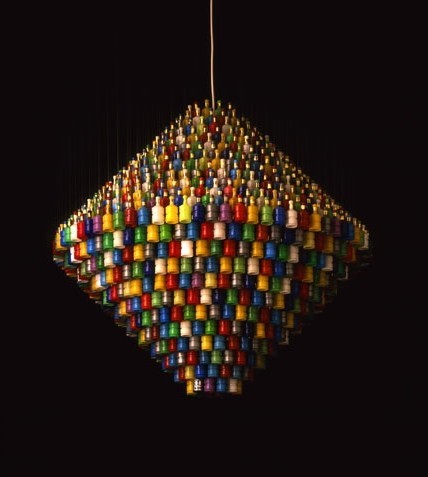Stuart Haygarth
01 Dec 2009 - 30 Jan 2010

© Stuart Haygarth
Millennium, 2004
Popped Party Poppers
Diameter: 86cm,
Hanging height: 170cm,
Hanging platform: 86 x 86cm
Millennium, 2004
Popped Party Poppers
Diameter: 86cm,
Hanging height: 170cm,
Hanging platform: 86 x 86cm
STUART HAYGARTH
"Found"
1 December 2009 – 30 January 2010
In his first exhibition at Haunch of Venison London, British artist and designer Stuart Haygarth examines his ongoing relationship with abandoned objects and his fascination with taxonomy through a series of new furniture works, lamps and chandeliers. Finding beauty in everyday, discarded items, the artist's work challenges perceived notions of the precious and beautiful.
Haygarth has spent many years gathering seemingly insignificant, discarded items such as ceramic figurines, spectacles, glassware and plastic objects whilst beachcombing, cycling and on excursions to markets and car boot sales. These are then sorted and graded, methodically stored by colour, material and subject. Often inspiring the final work through their form, previous use, tactile qualities and their relationship to light, the found materials are then painstakingly compiled to create lamps and furniture, giving otherwise banal and overlooked objects a new significance.
Haygarth sees his years of collecting and studying our unwanted items as an opportunity to investigate our social behaviour and habits. Haygarth has been gathering smashed car wing mirrors from narrow roads and 'hot spots' in London, such as the Rotherhithe tunnel, using them to create several new objects including a revolving mirror-ball with 350 smashed wing mirrors attached to a mirrored sphere, and a series of wing-mirror shaped tables complete with smashed glass surfaces. Haygarth is struck by the complex emotions and stories evoked by these shattered mirrors and the fact that modern society moves at such a fast pace, courting risk.
Haygarth has also continued to explore his famed fascination with spectacles, creating a series of urchin lights for the exhibition; shaggy cascades of frame parts lit from within, and an optical chandelier made from tinted lenses. Hours and weeks are spent measuring and configuring the layout of the assembled quantities until they are ready to be fixed to a central platform or base, creating a unified visual work of art.
"Found"
1 December 2009 – 30 January 2010
In his first exhibition at Haunch of Venison London, British artist and designer Stuart Haygarth examines his ongoing relationship with abandoned objects and his fascination with taxonomy through a series of new furniture works, lamps and chandeliers. Finding beauty in everyday, discarded items, the artist's work challenges perceived notions of the precious and beautiful.
Haygarth has spent many years gathering seemingly insignificant, discarded items such as ceramic figurines, spectacles, glassware and plastic objects whilst beachcombing, cycling and on excursions to markets and car boot sales. These are then sorted and graded, methodically stored by colour, material and subject. Often inspiring the final work through their form, previous use, tactile qualities and their relationship to light, the found materials are then painstakingly compiled to create lamps and furniture, giving otherwise banal and overlooked objects a new significance.
Haygarth sees his years of collecting and studying our unwanted items as an opportunity to investigate our social behaviour and habits. Haygarth has been gathering smashed car wing mirrors from narrow roads and 'hot spots' in London, such as the Rotherhithe tunnel, using them to create several new objects including a revolving mirror-ball with 350 smashed wing mirrors attached to a mirrored sphere, and a series of wing-mirror shaped tables complete with smashed glass surfaces. Haygarth is struck by the complex emotions and stories evoked by these shattered mirrors and the fact that modern society moves at such a fast pace, courting risk.
Haygarth has also continued to explore his famed fascination with spectacles, creating a series of urchin lights for the exhibition; shaggy cascades of frame parts lit from within, and an optical chandelier made from tinted lenses. Hours and weeks are spent measuring and configuring the layout of the assembled quantities until they are ready to be fixed to a central platform or base, creating a unified visual work of art.
